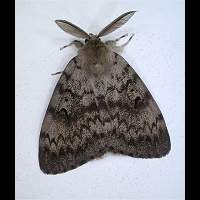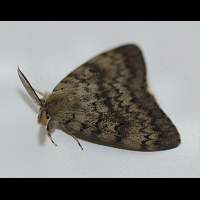Gypsy Moth Lymantria dispar
The males and females of the Gypsy Moth differ considerably. In the pictures on this page is a male. They are greyish brown, plain brown or warm light brown and have a dark fringe of the wing. Over the wing run several blackish zigzag lines. Especially the sharp, black heavily indented line running over two thirds of the wing is characteristic. Sometimes males are as dark as the lines are, making these practically invisible. The female is white. Most of the lines seen in the male are present in the female as well, especially near the edge of the wing. Often they do not rum to the other side of the wing though. Usually the sharply indented line mentioned before does. Reaching a wingspan of 48 to 65mm, the Gypsy Moth is rather big.
The eggs are being laid in summer. The female makes a kind of carpet using her own body hair. The carpet is glued on to a tree trunk. The eggs are laid on this carpet in one big group. From a distance the group of eggs is very similar to some kind of fungus. The eggs overwinter and hatch in May. The larvae do not start to eat, but rather wait for a strong wind. They then let go and are dispersed over many miles by the wind. After landing in a tree, shrub or plant the young will start feeding. By the end of June they'll spin a cocoon in which they pupate. Like with all species in this family the caterpillars are extremely hairy. And what's more they are very variable too. Usually best identified by the warts on the back. Those on segments 1 to 5 are blue and those on segments 9 and 10 are red. On top of all warts is a red dot from which brownish hairs grow. The Gypsy Moth has a very broad taste when it concerns the foodplants. Over 500 plant species have been found to serve as foodplants in the mean time. Very popular are oak and poplar, but even conifers are eaten. The caterpillars will reach a length of some 50mm.
The Gypsy Moth is on the wing in July and August mainly. Males love to fly and do so even in broad daylight. They are attracted to light as well. Females are capable of flying, but rarely do so. They usually stay near the cocoon they came from. Female nor male will feed while being adult. The Gypsy Moth may appear in huge numbers and can be extremely devastating in forests. After a year of abundancy, numbers usually decline in the years after, then start growing again in the next couple of years. Apparently this is a 5 year cycle. The Gypsy Moth is common in most of Europe, Northern Africa, temperate Asia and Japan. Also abundant at times in Northeastern America, where it was introduced accidentally in 1869 near Boston.
In Britain it used to be a resident in rapidly declining numbers up to 1907 when it got extinct. The caterpillar of the British subspecies probably only lived on creeping willow and bog myrtle in fens and died out because these dried out. Immigrants, all males, appear almost yearly in very small numbers.
The males and females of the Gypsy Moth differ considerably. In the pictures on this page is a male. They are greyish brown, plain brown or warm light brown and have a dark fringe of the wing. Over the wing run several blackish zigzag lines. Especially the sharp, black heavily indented line running over two thirds of the wing is characteristic. Sometimes males are as dark as the lines are, making these practically invisible. The female is white. Most of the lines seen in the male are present in the female as well, especially near the edge of the wing. Often they do not rum to the other side of the wing though. Usually the sharply indented line mentioned before does. Reaching a wingspan of 48 to 65mm, the Gypsy Moth is rather big.
The eggs are being laid in summer. The female makes a kind of carpet using her own body hair. The carpet is glued on to a tree trunk. The eggs are laid on this carpet in one big group. From a distance the group of eggs is very similar to some kind of fungus. The eggs overwinter and hatch in May. The larvae do not start to eat, but rather wait for a strong wind. They then let go and are dispersed over many miles by the wind. After landing in a tree, shrub or plant the young will start feeding. By the end of June they'll spin a cocoon in which they pupate. Like with all species in this family the caterpillars are extremely hairy. And what's more they are very variable too. Usually best identified by the warts on the back. Those on segments 1 to 5 are blue and those on segments 9 and 10 are red. On top of all warts is a red dot from which brownish hairs grow. The Gypsy Moth has a very broad taste when it concerns the foodplants. Over 500 plant species have been found to serve as foodplants in the mean time. Very popular are oak and poplar, but even conifers are eaten. The caterpillars will reach a length of some 50mm.
The Gypsy Moth is on the wing in July and August mainly. Males love to fly and do so even in broad daylight. They are attracted to light as well. Females are capable of flying, but rarely do so. They usually stay near the cocoon they came from. Female nor male will feed while being adult. The Gypsy Moth may appear in huge numbers and can be extremely devastating in forests. After a year of abundancy, numbers usually decline in the years after, then start growing again in the next couple of years. Apparently this is a 5 year cycle. The Gypsy Moth is common in most of Europe, Northern Africa, temperate Asia and Japan. Also abundant at times in Northeastern America, where it was introduced accidentally in 1869 near Boston.
In Britain it used to be a resident in rapidly declining numbers up to 1907 when it got extinct. The caterpillar of the British subspecies probably only lived on creeping willow and bog myrtle in fens and died out because these dried out. Immigrants, all males, appear almost yearly in very small numbers.






